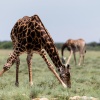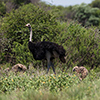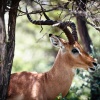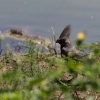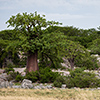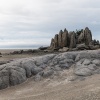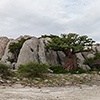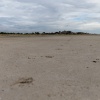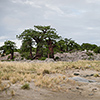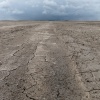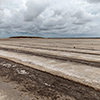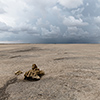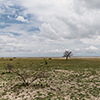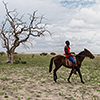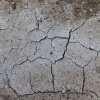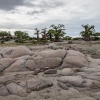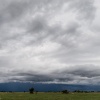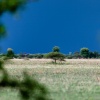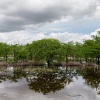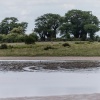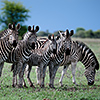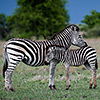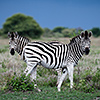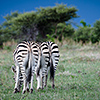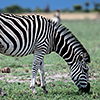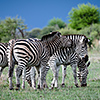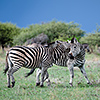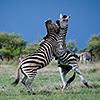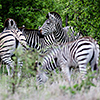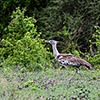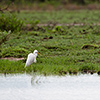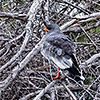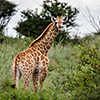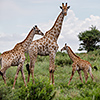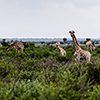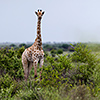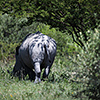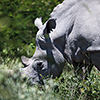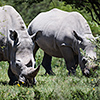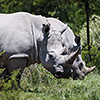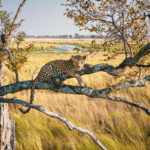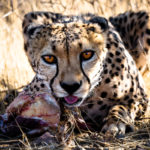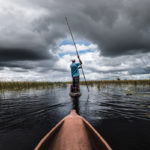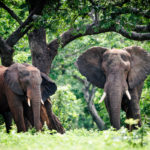Makgadikgadi – The Salt Pan with Zebra Crossings
When travelling Botswana by car then kilometres pretty much pile up on the clock as many roads lead around the national parks. One of those national parks is the Makgadikgadi salt pans area in the northeast of the country. Coherently seen they are the largest of its kind on planet Earth. The rare minerals of the salt draw thousands of animals to see the pans. In particular when African spring changes into summer, when rainy seasons starts, then rhinos, giraffes and large flocks of Zebras make their way to those depressions where rain water gathers to feed lush vegetation and mighty baobab trees.
Jeeez, sometimes I really don’t know what’s going on with my GPS. I’ve got no clue why sometimes it displays the path into Sua pan, the eastern Makgadikgadi pan, and sometimes it doesn’t. Hence that police road block down the road comes along just at the right moment. Having asked the two police officers where to go I get two completely different directions, emphasised by two completely different route indications. Distinguishing the left-hand from the right-hand side is generally not the strong point of Africans.
Also guessing distances is not their asset. Following the wrong directions being given you can quickly end up having driven some 300-400km in the wrong direction. Hence I trust my sense of direction only that finally finds GPS-backed the right way. Having left the few tar roads all things called driving become quickly interesting as only 4×4 drive is capable to make you move through unleashed nature. At the edge of Sua pan I instantly notice the presence of water and realise that my off road drive will become interesting…
It doesn’t take much time until I have to cross larger puddles and mud holes. Their slippery bottom means quite a potential to get stuck severely, hence I deflate the tyres down to a pressure of ~1.2 bar. In a jiffy I get through all water filled wheel ruts, puddles and mud holes now. The engine revs, making the wheels tear up and swirl up the mishmash of water and dung contributed by elephants, giraffes and rhinos. Well, in next life please don’t let me reappear as mud flap please…
In the far distance I see a couple of locals blocking my way. Apparently they got severely stuck. I walk over and ask if I can help. They need a hilift jack to get out, something that my jeep fortunately is equipped with. Of course I help them to set their normal car free. As a little thankyou they show me the right way to Kubu Island, an island amidst the Sua salt pan.
All dodgy direction hints aside, at places where GPS and reality diverge totally, where GPS shows only one but where virtually are more than 8 possible paths, the knowledge of locals is worth a mint. I would have barely reached my destination for the day without them and would have had to spend the night in the realm of stinking super puddles. However, now I am on Kubu Island, camping among the majestic baobab trees. At breakfast I meet a couple of South Africans. Instantly we like each other and decide to drive together through Sua towards the smaller Nxai pan.
To reach the Nxai National Park we have to cross the Makgadikgadi main pan. After some kilometres we get stuck as our jeeps break through the actually solidly looking crust. Under that crust water and mud await us. What mean trap… We set our jeeps free and drive back to make our way alone the edge of the pan. Our jeeps cut themselves through soft sand and countless puddles towards Nxai pan, that we arrive on the last kilometres through the one and only tar road.
The smaller Nxai pan is not as bare as its larger fellow member and is entirely surrounded by lush green vegetation. For giraffes and elephants that is a little paradise. Even from far away you can spot their long towering necks, or elephants as large greyish nugget amidst the opulent bush. There’s always time for a little game drive, in particular when the sky turns dramatically dark as some clouds announce to dump their load. Against that background all zebras around truly look as if they are out of a fairy tale. Though I have hurry up as the sun is about to set. In Africa that means that it gets dark (in the literal meaning of black!) within the blink of an eye.
I put up my camp, eat something, disappear in my roof top tent and fall asleep to the sound of lions hunting in the background. 12 years ago that noise left me scared shitless, but now it’s pure Africa and the most beautiful I can imagine. The next morning I wake up and open my tent. The sky is cloud covered but the view of peacefully breakfasting giraffes compensates the bad weather fully. Curiously they gaze at me. Awesome! That’s how Africa should always be. At the famous Kruger National Park you won’t get such experiences as you’ll camp completely fenced. To get such encounters Botswana is unbeatable!
Being directly located at the edge of Kudiakam pan, a smaller depression neighbouring Nxai pan, there’s a group of seven baobab trees named Sleeping Sisters. The British explorer and painter Thomas Baines gave them their international breakthrough, as papers would headline it today. People say those trees are a couple of thousands of years old. In spring the baobabs get framed by Botwana’s omnipresent flocks of zebras. Curiously they gaze at my human-made vehicle. Despite all relaxedness though the lead stallion, so called Big Boss, always positions itself between potential risks and the herd, meaning it never loses me out of sight.
Zebras often appear to be kind of “permanently” pregnant and fat; on the other hand they are quite virile animals. Logically they need quite some energy, although their primary food grass doesn’t have all too much essential nutrients on offer. Hence they are bulk eaters and in their bellies the bulk of grass starts to ferment. People being on a cabbage diet will know what those animals feel like as that sort of food logically produces a LOT of gas, gas that inflates zebras. If you’re close to zebra you hear them farting very very often. What a funny fact :-) One of the most beautiful moments in nature though is to meet giraffes. Their presence is a moment of supreme peacefulness. When their towering necks peep out of the bush it appears as if they form a guard of honour for the human stranger.
Having driven a few metres further my jaw literally drops as the strange grey heap of cement turns out not to be made by termites. It has got four legs, moves, eats and even conceals a second grey heap. Feast on fresh juicy grass a white rhino mother and its juvenile cub move through the bush and come very very close to my jeep. What an impressive animal…! 12 years ago I was unlucky to eye-witness its beauty.

